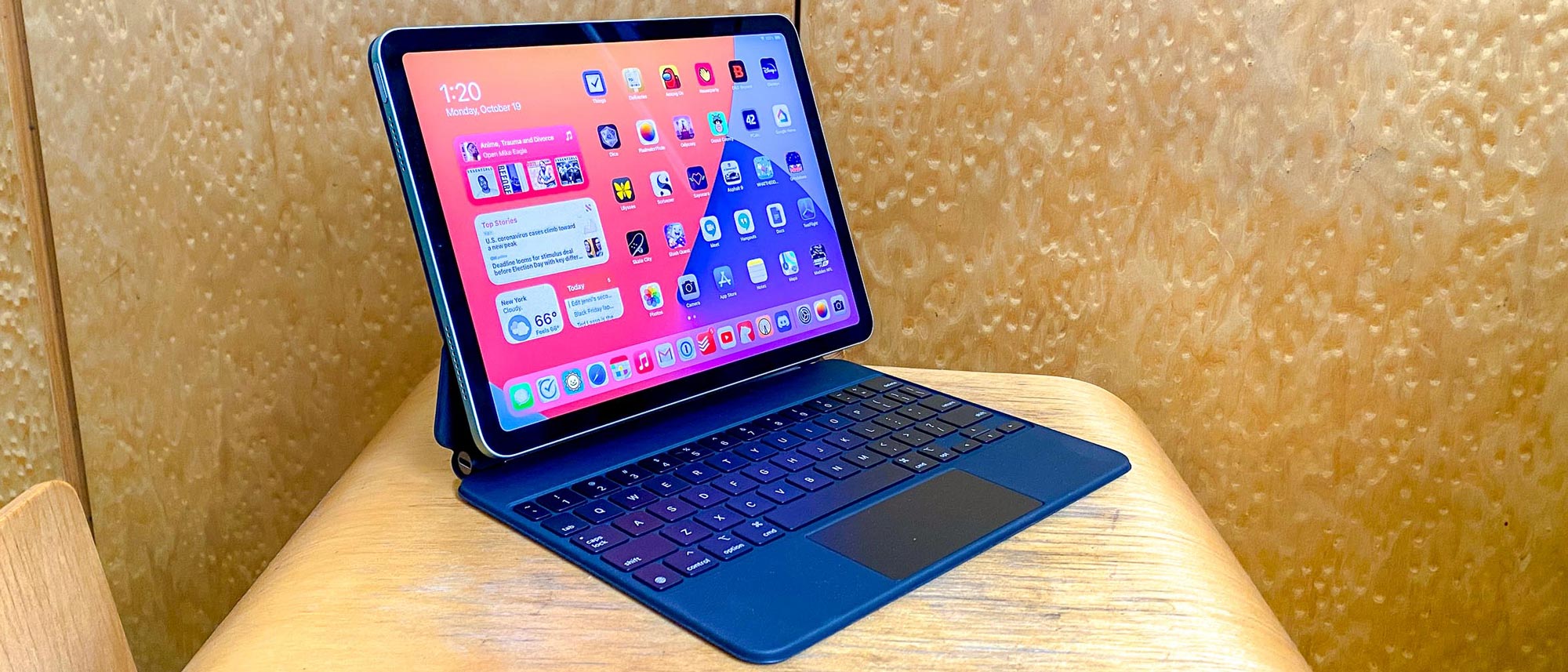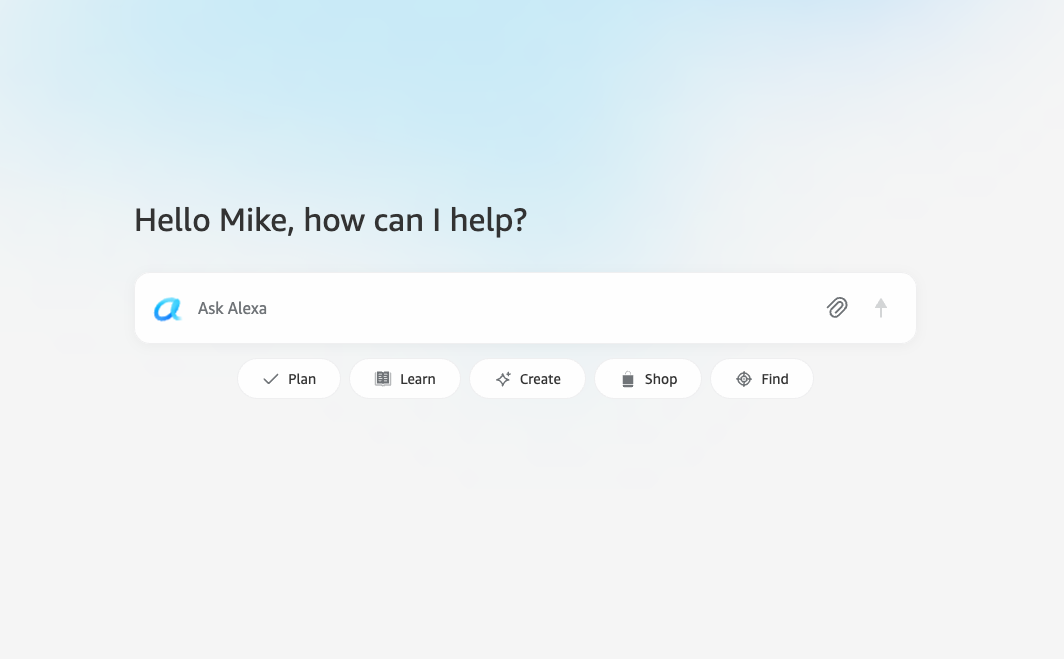Tom's Guide Verdict
The iPad Air 4's screen, charging and performance make it one of the best iPads ever, as it's essentially a more affordable iPad Pro.
Pros
- +
Elegant thin and light design
- +
Super-fast A14 Bionic processor
- +
Bright, colorful and sharp display
- +
Excellent webcam
- +
USB-C charging
- +
Magic Keyboard and 2nd Gen Apple Pencil support
Cons
- -
No Face ID
- -
RIP headphone jack
- -
Expensive accessories
Why you can trust Tom's Guide
OS: iPadOS 14
CPU: A14 Bionic
Storage: 64GB, 256GB
Display: 10.9-inch (2360 x 1640 pixels) Liquid Retina
Rear cameras: 12MP wide (f/1.8)
Video: Up to 4K at up to 60 fps
Front camera: 7MP TrueDepth
Wireless: Wi-Fi 6, optional 4G LTE
Battery: 28.6 watt-hour
Battery life: 10:29 (tested)
Size: 9.7 x 7 x 0.24 inches
Weight: 1 pound
Price: $599
The $599 Apple iPad Air (2020) occupies a pricing tier between the $329 10.2-inch iPad 9 (2021) and the $799 iPad Pro 2021 (11-inch). It's a mid-range iPad option for those who want Pro-level perks without the need to pay up to a grand with the Magic Keyboard. But is this iPad great enough to spend almost twice as much as you would on the standard iPad? I'd say so, as it's my new favorite iPad.
Not only does the 10.9-inch iPad Air 4 impress with its flat-edge design (which has the cool color options of the iPhone 12 in the shell of the 11-inch iPad Pro), but its Apple Pencil (2nd Gen) and Magic Keyboard support mean it's more capable of replacing your laptop (provided you spend more for those accessories). It's also got speedy A14 Bionic performance and USB-C charging, two upgrades I wish the normal iPad could get.
This iPad Air (2020) review will explain how the tablet's only real downsides are comparative issues you might not notice otherwise. Its screen is bright and colorful, but competitors shine brighter and produce more color. Oh, and its long battery life is outpaced by two of its competitors — which include the normal iPad.
That said, this model was replaced — and Apple no longer sells it. Our Apple iPad Air (2022) review) shows how its internal upgrades (its speedy M1 chip and 5G connectivity) make a whole deal of improvement. But has the new tablet rendered the previous model obsolete? Here's everything to know about why Apple's iPad Air 4.
iPad Air (2020) review: Release date and price
The iPad Air 4 came out on Friday, Oct. 23, 2020. It starts at $599 for the 64GB configuration, and you can upgrade to 256GB for $150 — which brings you to $749. LTE cellular connectivity costs $130 more, bringing the max price to $879.
That price looks good next to the iPad Pro, but some may experience sticker shock if they remember how the iPad Air 3 was $499. Fortunately, we've started to see (minor) sale pricing so far.
iPad Air (2020) review: Design
The iPad Air 4 looks enough like an iPad Pro that it could fool you into thinking Apple just released new colorways of the 11-inch version of its high-end iPad. It's available in the green model we tested (a minty fresh option I'd recommend), blue (which I wish I'd seen in person), rose gold, silver and Space Gray. The iPad Air (2022) is identical in shape and size and ports.
Get instant access to breaking news, the hottest reviews, great deals and helpful tips.
Thinking about the iPad Air 4 as the successor to the iPad Air 3, you can see how removing the home button from the bottom of the screen gave Apple the ability to increase its screen size, as the iPad Air 4's 10.9-inch screen is bigger than the iPad Air 3's 10.5-inch panel.
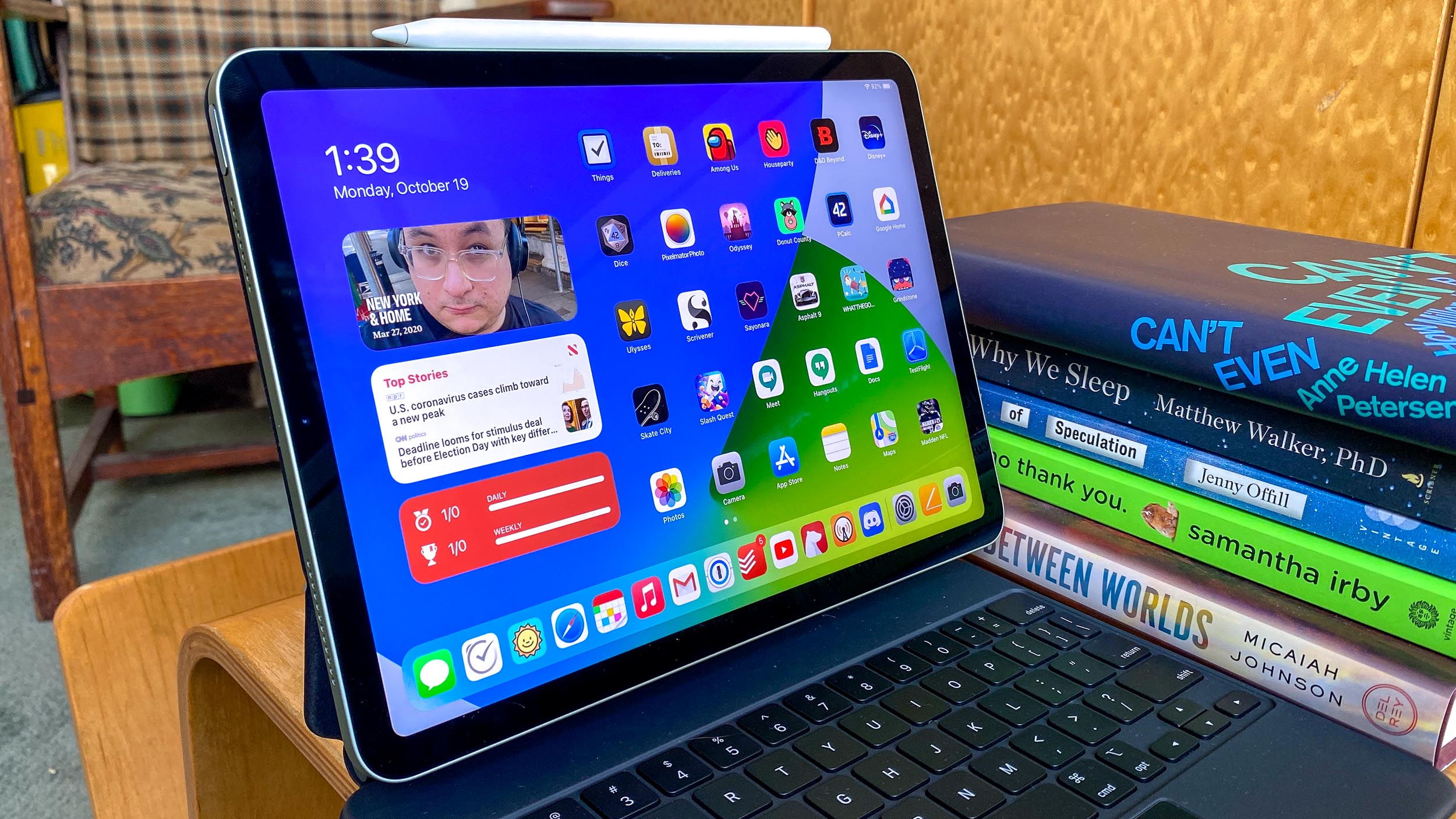
The other key differentiators are in its buttons and security measures. Apple opted to give the iPad Air 4 a Touch ID fingerprint scanner that's hidden inside of its lock button. I prefer the iPad Air 4 to the Galaxy Tab S7 (which also puts its fingerprint sensor in its lock button), as Apple's button sticks out slightly, making it easier to detect visually. The Tab S7's fingerprint scanner is slightly recessed, making for a minor search mission each time.
The iPad Air 4 also dumps the Lightning port for USB-C, which will help me cut down on the number of cables I use (retiring another Lightning cord for just my iPhone and AirPods). This is a welcome change and one I wish the regular iPad would also get.
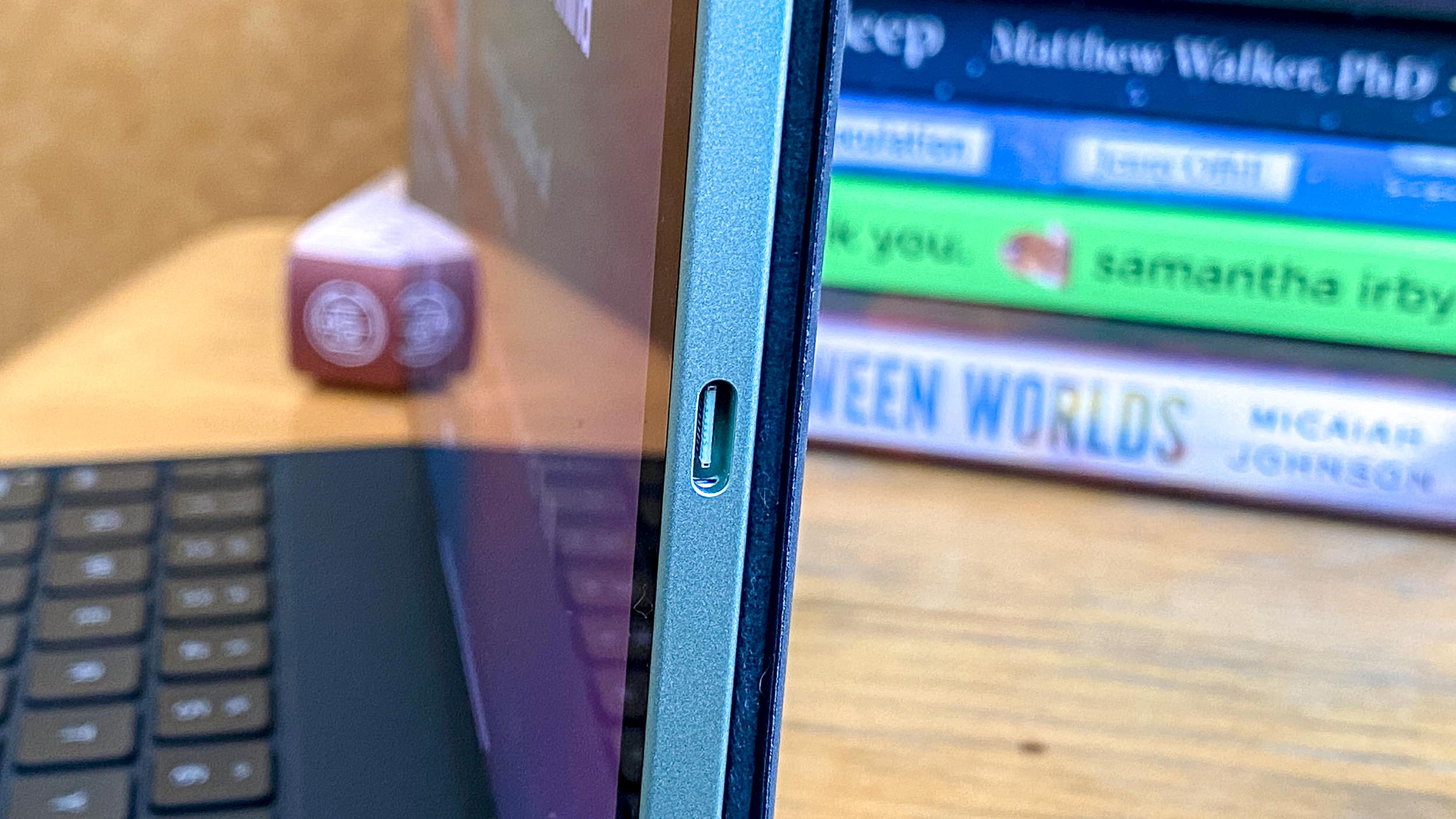
The iPad Air 4 doesn't have a headphone jack, but neither does the iPad Pro nor Tab S7. Apple's letting too many devices drink from the iPhone's fountain of 'courage,' and that's probably annoying for those who haven't jumped to wireless headphones. And while I wish this trend would end, I love my AirPods Pro and I've started to just keep my wired headphones connected to my podcast mic, the only device that truly needs them.
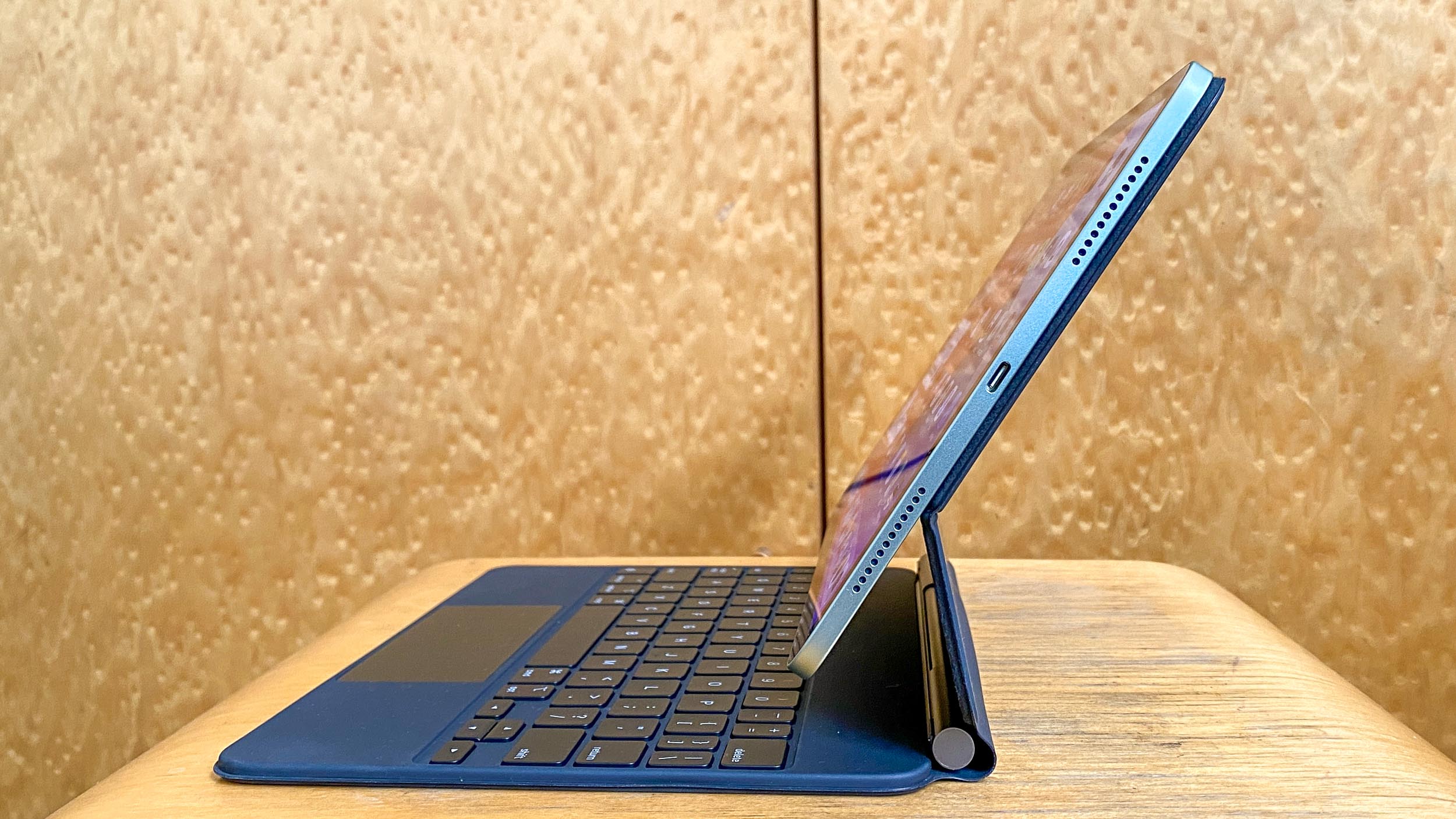
Measuring 9.7 x 7 x 0.2 inches and weighing 1 pound even, the iPad Air 4 has the same measurements as the 11-inch iPad Pro, while being slightly thinner and lighter than the 10.2-inch iPad (9.8 x 6.8 x 0.3 inches, 1.1 pounds). The Samsung Galaxy Tab S7 (10 x 6.5 x 0.2 inches, 1.1 pounds) is also a touch heavier.
iPad Air (2020) review: Display
The iPad Air 4's screen is sharp, but it could stand to be brighter. Watching a 4K version of the film Midsommar on the iPad Air 4, I saw plenty of detail when Florence Pugh's character hallucinated that her feet were made of grass, with blades of grass weaving in and out and poking up. Color reproduction looked good when I watched a sneak preview for The Suicide Squad, where the reds and blues of Peacemaker's outfit practically popped off the screen.
Later on, I noticed a wide range of greens in the foliage surrounding the According to our Klein K10-A colorimeter, the iPad Air 4 produces 102.9% of the sRGB color spectrum, a rate that falls under both the Galaxy Tab S7's ratings (111% on Natural mode, 152% on Vivid) and the 122.9% from the 12.9-inch iPad Pro as well. The regular iPad comes close, at 97%. The iPad Air (2022) beats its predecessor here, but its 111.8% score is only a minor upgrade.
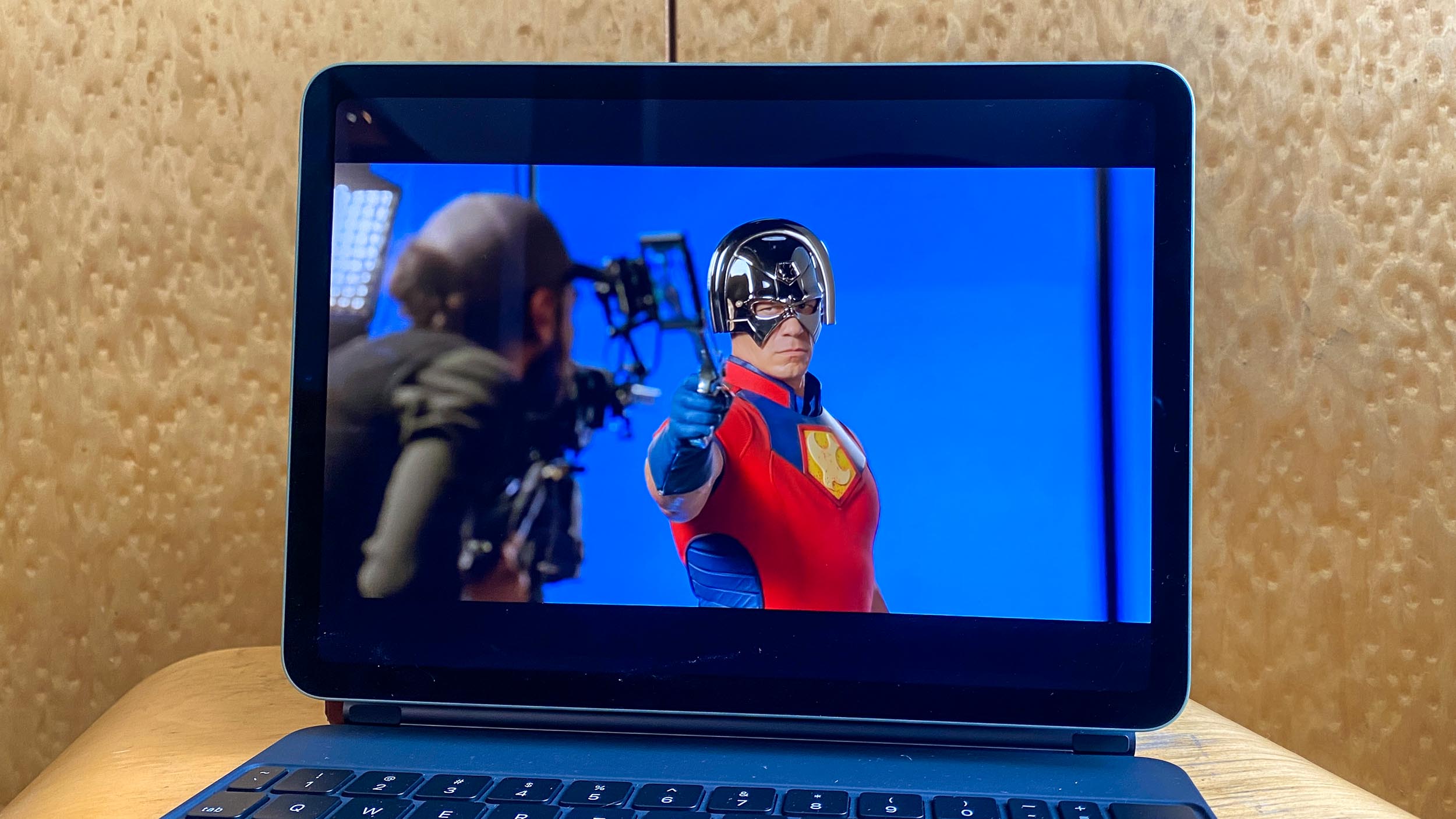
The iPad Air 4 maxes out at 440 nits of brightness, a rating that's good on its own, but outshined by its competitors. That includes even the normal iPad (484 nits), which is only slightly dimmer than the Galaxy Tab S7 (499 nits). The iPad Pro (559 nits) gets even brighter. The iPad Air 5 is in the middle, at 484 nits. This, again, is a measurable yet minor upgrade from the iPad Air 4.
In terms of sharpness, the iPad Air 4 has a 264ppi pixel density, which is the same rate as you find in the normal iPad and the iPad Pro. The Tab S7's 11-inch 2560 x 1600-pixel panel has a density of 276 ppi, a hair better.
The other reason to go for the iPad Air 4 over the iPad is its screen has a few extra perks. Those include full lamination and an anti-reflective coating, so it's more resistant to glare and fingerprints.
Watching a scene of the documentary You Cannot Kill David Arquette, the hues of the actor's pink and blue luchador mask and tights stayed strong beyond the normal 30 degrees to the left and right, and even stayed accurate when I turned the iPad Air 4 85 degrees to the side. And even in the darker scenes of this film, I saw much less of myself reflected in the tablet's screen than I had on the Galaxy Tab S7.
The iPad Air 4 doesn't offer the smoothness of 120Hz refresh rates that the iPad Pro and Tab S7 do. I don't think most folks outside of early adopters will notice.
iPad Air (2020) review: Touch ID security
The iPad Air 4 feels almost like a merger of the iPad and iPad Pro when it comes to the Touch ID fingerprint scanning power button. I don't know why Apple decided not to include the iPad Pro's Face ID selfie camera when the Air already has the tiny bezels that the iPad Pro fits that sensor into.
The Touch ID sensor in the iPad Air 4 allows for fast authentication when using Apple Pay and using passwords, but I wish they hadn't ditched Face ID. Why? Well, the iPad Pro's facial recognition just works, provided your hand isn't covering up that camera (I've had that happen to me a number of times, though).

The iPad Air 4's A14 Bionic chip gives it a serious speed advantage over most tablets.
Either way, the iPad Air 4's Touch ID power button is a nifty trick, and pulled off better than the Galaxy Tab S7's as I've said earlier. Samsung gets points here, though, by giving both facial and fingerprint recognition, when Apple only offers one.
The iPad Air 4's fingerprint sensor looks like one way Apple could give its iPhone 13 a Touch ID sensor if the company fails to embed the biometric scanner in its screen. The iPad Air 5 has the same Touch ID, and lacks Face ID.
iPad Air (2020) review: A14 Bionic performance
The iPad Air 4 runs on the A14 Bionic chip, which has a hexa-core CPU and a quad-core GPU, which combine to give it a serious speed advantage over most tablets. I saw zero stutter under basic everyday usage — splitting its screen between 12 Safari tabs and a 1080p YouTube video (The Batman 2021 trailer) — with Tweetbot open in slide-over mode. With all of that going on, I opened an image in the Pixelmator Photo image editor, and saw its ML Super Resolution up-rez'ing complete in less than 30 seconds.
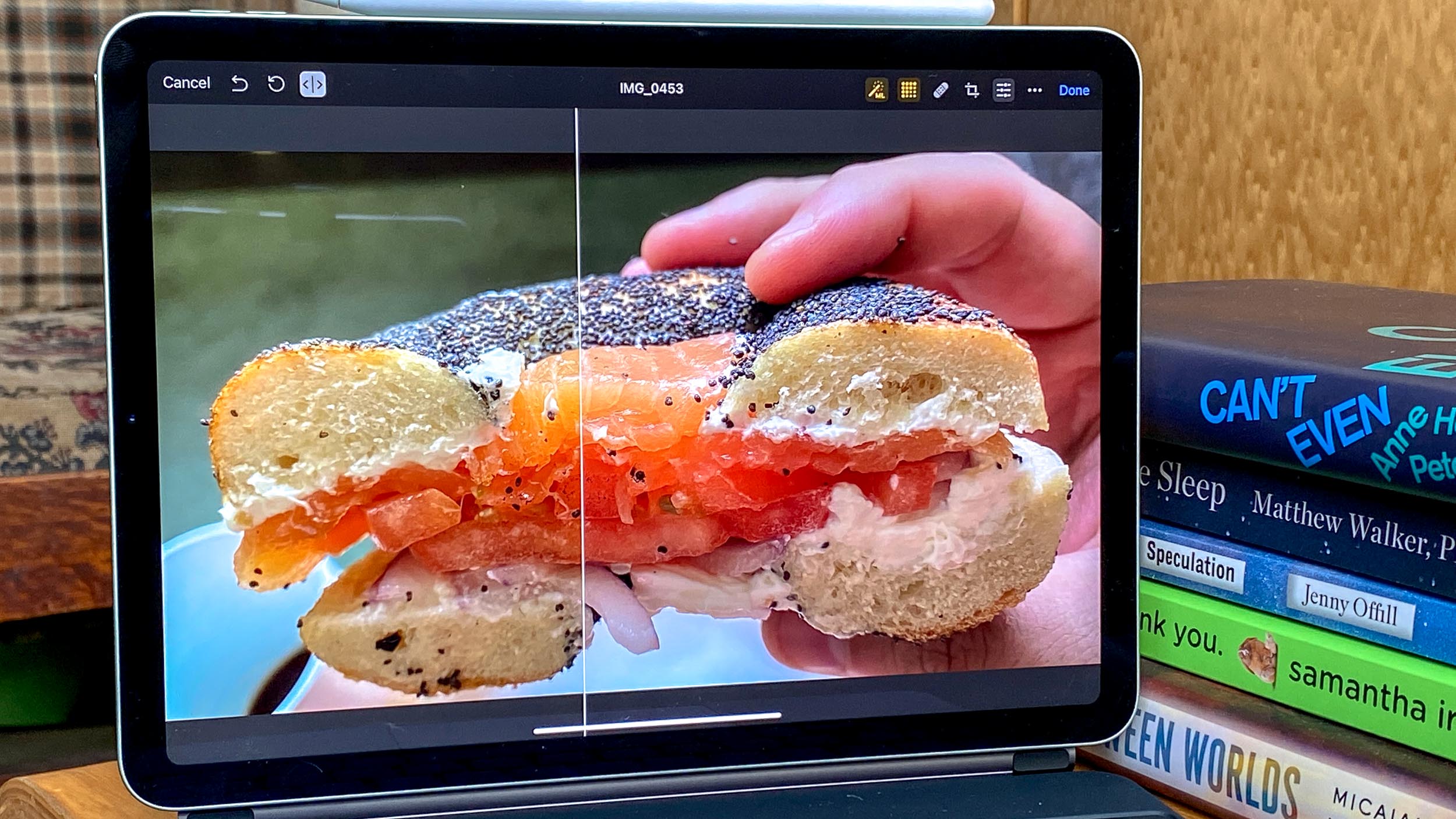
The iPad Air 4 earned a 4,262 on the Geekbench 5 general benchmark, which beats its main competitor. The Galaxy Tab S7 (Snapdragon 865+) hit a mark of 3,074 and the iPad 2020 (A12 Bionic) notched 2,685. The iPad Pro 2020 (A12Z Bionic) is the only model that did better, at 4,720. This is the biggest win for the iPad Air 5, which notched a 7,151 score.
The mobile racing game Asphalt 9: Legends ran super-smoothly on the iPad Air 4, as I drove a Mitsubishi lancer around a snowy hill. I saw nary a stutter or frame drop as I knocked cars off the road and sped through to the finish line in first place.
iPad Air (2020) review: Audio
The iPad Air 4's stereo speakers produce enough sound to fill not just my small-to-medium-sized home office, but also spill over sweet tunes to adjacent rooms. As I listened to Fleetwood Mac's "Dreams" on the tablet, Stevie Nicks' serene vocals filled the room around me, taking some of the stress out of my shoulders as I noted the crisp-hitting drum cymbals.
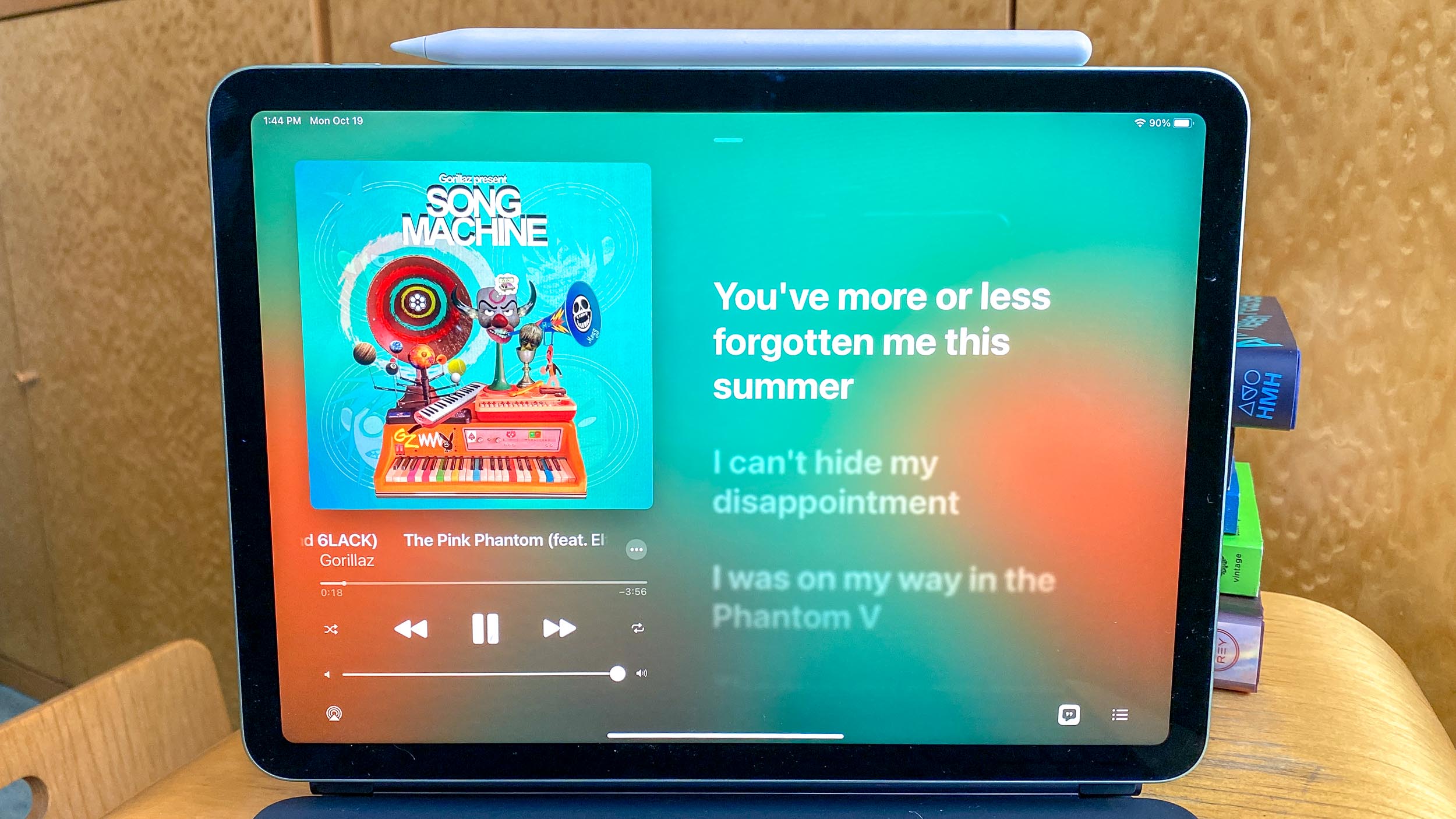
The big difference between the Air 4's sound and the iPad Pro's sound is in its smarts. You'll get a true stereo sound experience on the Air 4 in landscape mode, while the iPad Pro has a quad-speaker setup that allows you to consistently get stereo sound no matter which position it's in, as it's smart enough to adjust to stereo when you've got the tablet in a vertical/portrait orientation.
iPad Air (2020) review: Apple Pencil and Magic Keyboard
My favorite part of the iPad Air 4 is that it means you don't have to spend $800 to get to use (and buy) Apple's best iPad accessories. Let's start with the Apple Pencil 2nd Gen, which simply snaps to the top edge of the iPad Air 4, and doesn't charge by plugging it into the port on the bottom edge (as the original Apple Pencil does with Lightning port-based iPads).

And that's important because iPadOS 14 gives you Scribble. It's the ability to write into text fields with the Apple Pencil and have that handwriting turn into legit text. And it even works with my chicken-scratch.
Selling a keyboard for nearly the price of the entry-level iPad just doesn't feel right.
More importantly, the iPad Air 4's support for the Magic Keyboard means that typing on this iPad is as easy as on the iPad Pro. As I explained in my iPad Pro Magic Keyboard review, its keys make for a much more comfortable typing experience thanks to increased vertical travel, the movement that makes them feel like you're using a real keyboard, and not clicking the small sensors of the iPad Smart Keyboard Folio. The Magic Keyboard also wins because it has a touchpad, which the Smart Keyboard always lacked — and which makes the iPad Air 4 more like a real laptop.
I'm plenty used to typing on the Magic Keyboard (the 2018 iPad Pro is becoming my main computing device when I'm off the clock), and hit 78 words per minute (with 97% accuracy) on my first try of the 10FastFingers typing test.

Frustratingly, the Magic Keyboard costs too much at $300. I don't know how Apple makes it, but selling a keyboard for nearly the price of the entry-level iPad just doesn't feel right. That being said, anyone considering the $179 Smart Keyboard Folio should really pony up the extra $121. It's that much better of a typing experience. Samsung's Galaxy Tab S7 Bookcover Keyboard may also offer a touchpad, but its number keys are small and its overall design is a clunky 2-piece design that makes the Magic Keyboard's so-simple attach/detach process look even more seamless than it already is.
One more thing about that Magic Keyboard, if you're waiting to buy one. We've learned that Apple seems to have a 2nd Gen Magic Keyboard, which would likely support both the iPad Pro and Air, in the works.
The $129 Apple Pencil 2nd Gen also is a bit too pricey, and I wish they'd include it for free as Samsung does with the Galaxy Tab S7's S-Pen. That being said, the Apple Pencil 2 feels a lot more substantial than the S-Pen. Again, though, do not buy the $99 Apple Pencil 1 for the iPad Air 4, the extra $30 for the 2nd gen Pencil is more than worth it. The Apple Pencil 1 isn't a good fit for the Air 4 as it can't be plugged into the base of the iPad Air 4 without a USB-C to Lightning adapter.
iPad Air (2020) review: Cameras
Some people will use the iPad Air 4 as a camera, and who am I to say they shouldn't? Apple's definitely encouraging tablet photography by giving the iPad Air a 12-megapixel wide-angle webcam. That sensor did a good job of capturing the reds and yellows of a gala apple I ate as a mid-review snack, as well, as the browns, blues and blacks in the Persona 5 gift box I placed the apple upon.
The 7MP front-facing webcam provides sharp and accurate image captures, as I tested with a selfie in my living room. I actually thought it captured a bit too much detail of my nose and skin.

But then I put the iPad Air 4 to the ultimate work-from-home-test, on a Google Meet call with my boss. After he said the video quality was "as good as, if not better than, a real webcam," I connected an external Logitech C920 webcam to my work laptop and joined the call from that device. Lo and behold, my boss' judgment was proven correct, when he could see their image quality side by side. The iPad Air 4's camera captured stronger greens on my t-shirt and handled sources of light better, allowing them to illuminate backdrops instead of just render as blown-out white areas in photos.
Just like with the Galaxy Tab S7, the iPad Air 4's camera bump protrudes a bit, and there's a little back and forth rocking if you lay the tablet screen-up on a table — the only way you ever should.
iPad Air (2020) review: Battery life
The iPad Air 4 offers all-day battery life, going 10 hours and 29 minutes on the Tom's Guide web-surfing-based battery test. This is 20 minutes more than the 10:09 time we got from the iPad Air 5, and it narrowly beats the iPad Pro (10:16), but the 10.2-inch iPad (12:57) and Samsung Galaxy Tab S7 (13:16) lasted longer. That difference may mean you're going to charge the iPad Air 4 a little more often, but not by much.

iPad Air (2020) review: Verdict
When relatives and friends ask me what tablet to buy, I'm telling them to get the iPad Air 4. It's not only faster and more stylish than the normal iPad, but the Magic Keyboard support means the iPad Air is finally a laptop beater. If its battery life was longer, or its display were brighter, Apple might have made the best tablet ever.
For longer battery life, you could get the Galaxy Tab S7, which costs $50 more or the much-cheaper iPad, but the iPad Air 4 beats both on speed. Those who want the brightest screen out there should check out the iPad Pro, but you're spending $200 more to get there, and many might not notice the differences.
Wondering about the iPad Air 5? Well, its only major win comes on performance, so only those pushing their iPads to the limit should consider that.
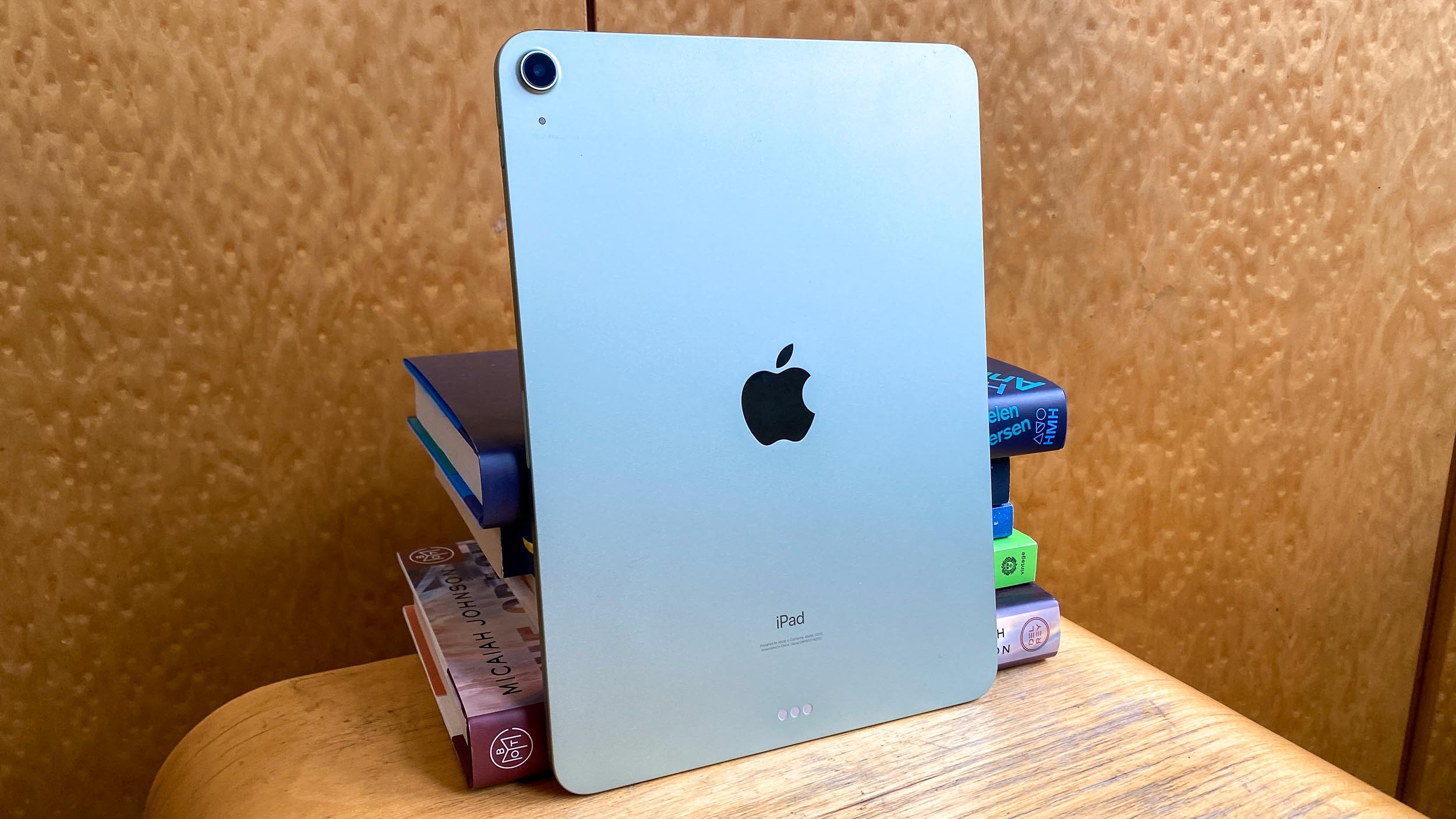
Overall, this iPad Air 4 review has shown why it's the best iPad out there, thanks to taking most of the iPad Pro features people will really appreciate, and making them available to a wider audience.

Henry was a managing editor at Tom’s Guide covering streaming media, laptops and all things Apple, reviewing devices and services for the past seven years. Prior to joining Tom's Guide, he reviewed software and hardware for TechRadar Pro, and interviewed artists for Patek Philippe International Magazine. He's also covered the wild world of professional wrestling for Cageside Seats, interviewing athletes and other industry veterans.
